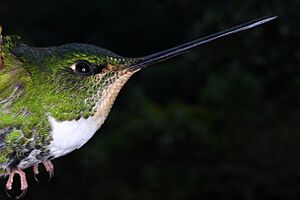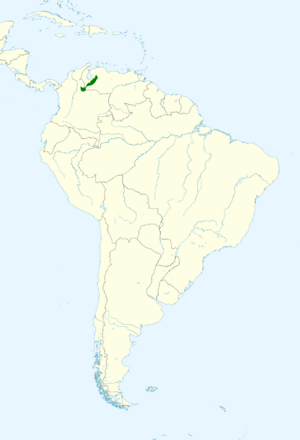Green inca facts for kids
Quick facts for kids Green inca |
|
|---|---|
 |
|
| In Mérida, Venezuela | |
| Conservation status | |
| Scientific classification | |
| Genus: |
Coeligena
|
| Species: |
conradii
|
 |
|
The green inca (Coeligena conradii) is a beautiful type of hummingbird found in the mountains of Colombia and Venezuela. Hummingbirds are known for their tiny size and incredibly fast wingbeats, which let them hover in the air. The green inca is part of a group called "typical hummingbirds."
Contents
About the Green Inca
What is a Green Inca?
The green inca is a specific species of hummingbird. It belongs to the family called Trochilidae, which includes all hummingbirds. It's also part of a smaller group called Lesbiinae.
How Scientists Classify the Green Inca
Scientists like to group living things to understand them better. Most big science groups, like the International Ornithological Committee, agree that the green inca is its own special species. However, some scientists think it might be a type of collared inca. They are still studying it to be sure!
Appearance of the Green Inca
The green inca is about 14.5 cm (5.7 in) long, which is roughly the length of a pen. A female bird might weigh around 6.7 g (0.24 oz), which is lighter than a few paperclips!
Male Green Incas
Adult male green incas are mostly bright, grassy green. They have a wide white band across their upper chest, like a collar. Their outer tail feathers are mostly white with green tips. Their wings are a brownish color.
Female Green Incas
Female green incas are also mostly grassy green on their upper bodies. They have a smaller white collar than the males. Their throat is a rusty color with green spots. The rest of their underside is grayish with green spots and a mottled (mixed) pattern.
Where Green Incas Live
Habitat and Location
The green inca lives in the Andes mountains. You can find them in northwestern Venezuela, between the states of Trujillo and Táchira. They also live in northern Colombia in the Norte de Santander Department.
They prefer to live inside and at the edges of wet, misty mountain forests, known as cloudforests. These forests are often covered in clouds and fog.
Elevation
Green incas usually live at high elevations. They are mostly found between 1,800 and 3,000 m (5,900 and 9,800 ft) above sea level. Sometimes, they can be seen as low as 1,500 m (4,900 ft).
Green Inca Behavior
Movement and Migration
As far as we know, the green inca does not migrate. It stays in the same area all year long. This means it is a "resident" bird throughout its range.
How Green Incas Find Food
The green inca is very clever when it comes to finding food. It uses a method called "trap-lining." This means it visits a regular circuit of flowering plants, going from one to another like it's following a path.
It mostly feeds on nectar from flowers found in the lower and middle parts of the forest. Sometimes, it will also feed in the very top of the trees. They get nectar from plants like Cavendishia, Fuchsia, and other plants in the Ericaceae family. They also drink nectar from vines.
Besides nectar, green incas also eat insects. They catch insects by "hawking," which means they fly out from a perch to snatch insects in mid-air. They can also pick insects off plants while hovering.
Reproduction and Life Cycle
Scientists do not know much about how green incas reproduce or raise their young. More research is needed to understand their breeding habits.
Green Inca Sounds
The most common sound a green inca makes is "a squeaky chatter." They also make other sounds, such as:
- A soft, low, reedy whistle that sounds like "tu-tee"
- A longer series of sounds, like "pip..pip..pip..."
- A repeated phrase, such as "tsi-tsi-tsiririt...tsi-tsi-tsiririt..."
- A short "spit" or "tsit" sound while they are looking for food.
Conservation Status
The IUCN (International Union for Conservation of Nature) has assessed the green inca as being of "Least Concern." This means that, for now, it is not considered to be in immediate danger of extinction.
However, the green inca lives in a small area. Its total population size is not known, and scientists believe the number of birds is slowly decreasing. Even though no immediate threats have been found, it's important to keep an eye on their population to make sure they stay safe.


